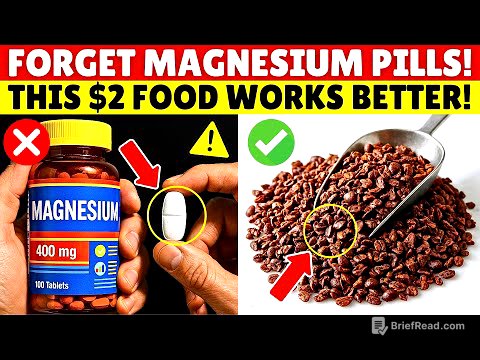TLDR;
This video provides a detailed explanation of nucleic acids, including their discovery, components, types (DNA and RNA), and functions. It covers the structure of nucleotides, the differences between DNA and RNA, the formation of phosphodiester bonds, and the three-dimensional structure of DNA as described by the Watson-Crick model. Additionally, the video explains the concept of dinucleotides, focusing on NAD, NADP, and FAD, and their roles as coenzymes in redox reactions.
- Nucleic acids are polymers made of nucleotide building blocks.
- DNA and RNA differ in their sugar composition and one of their nitrogenous bases.
- DNA stores genetic information, while dinucleotides like NAD, NADP, and FAD act as coenzymes in redox reactions.
Discovery and Basics of Nucleic Acids [0:00]
In 1868-69, Friedrich Miescher extracted a new molecule from the nucleus of pus cells, which he named Nucleon. This molecule was neither a protein nor a carbohydrate. Later, it was discovered that nucleon had acidic properties, leading to the name change to nucleic acid. There are two types of nucleic acids: deoxyribonucleic acid (DNA) and ribonucleic acid (RNA). Nucleic acids are polymers, and their building blocks are called nucleotides.
Components of a Nucleotide [1:12]
A typical nucleotide has three components: a pentose sugar, a phosphate group (or phosphoric acid), and a nitrogenous base. The pentose sugar is a five-carbon sugar. DNA contains deoxyribose, while RNA contains ribose. Deoxyribose is ribose with one less oxygen atom at carbon number two. The phosphate group is attached to carbon number five of the pentose sugar and gives DNA its acidic properties and negative charge.
Nitrogenous Bases: Purines and Pyrimidines [7:08]
There are two types of nitrogenous bases: purines and pyrimidines. Purines (adenine and guanine) have a double-ring structure, while pyrimidines (cytosine, thymine, and uracil) have a single-ring structure. Adenine is a six-amino purine, and guanine is a two-amino, six-oxy purine. Cytosine is a two-oxy, four-amino pyrimidine, thymine is a two-four dioxy, five-methyl pyrimidine, and uracil is a two-four dioxy pyrimidine.
Formation of a Nucleotide [10:46]
A nucleotide is formed when a pentose sugar, a nitrogenous base, and a phosphate group combine. Carbon one of the pentose sugar forms a glycosidic bond with the nitrogenous base through dehydration synthesis. Carbon five of the pentose sugar is attached to the phosphate group via an ester bond. A nucleoside is a base attached to a sugar, while a nucleotide is a sugar, base, and phosphate combined.
Nucleosides and Nucleotides: Adenosine, Guanosine, and More [12:57]
Adenine forms the nucleoside adenosine when combined with sugar. Adding one phosphate creates adenosine monophosphate (AMP), two phosphates create adenosine diphosphate (ADP), and three phosphates create adenosine triphosphate (ATP). Similarly, guanine forms guanosine, cytosine forms cytidine, thymine forms thymidine, and uracil forms uridine.
DNA vs. RNA: Key Differences [16:52]
DNA contains deoxyribose sugar and the nitrogenous base thymine, while RNA contains ribose sugar and the nitrogenous base uracil. DNA is a double-stranded molecule, whereas RNA is typically single-stranded.
Phosphodiester Bonds and Polynucleotide Chains [18:24]
Polymerization of nucleotides occurs through phosphodiester bonds, formed by DNA polymerase. The bond forms between the phosphate group on the five-prime carbon of one nucleotide and the hydroxyl group on the three-prime carbon of another, releasing two phosphates. This creates a polynucleotide chain with a five-prime phosphate end and a three-prime hydroxyl end.
DNA Structure: Anti-Parallel Strands and Base Pairing [24:46]
DNA is a double-stranded molecule with an anti-parallel nature, meaning one strand runs five-prime to three-prime, while the other runs three-prime to five-prime. The two strands connect through complementary base pairing: adenine pairs with thymine (via two hydrogen bonds), and guanine pairs with cytosine (via three hydrogen bonds).
Watson-Crick Model of DNA [27:37]
The Watson-Crick model describes DNA as a twisted staircase or helix. The uprights of the ladder are made of a sugar-phosphate backbone, and the rungs are made of nitrogenous base pairs. A single turn (360 degrees) contains 10 to 11 base pairs and covers a distance of 3.4 nanometers. The distance between two adjacent base pairs is 0.34 nanometers.
Chargaff's Rule and DNA Diameter [32:04]
Chargaff's rule states that the amount of adenine is always equal to the amount of thymine, and the amount of guanine is always equal to the amount of cytosine in DNA. The diameter of DNA is consistently 2 nanometers, which is maintained because a purine (double-ring) always pairs with a pyrimidine (single-ring).
Function of DNA and Introduction to Dinucleotides [38:25]
The primary function of DNA is to store genetic information. Dinucleotides are coenzymes derived from vitamins, playing a crucial role in various biochemical reactions.
Dinucleotides: NAD, NADP, and FAD [40:03]
NAD (nicotinamide adenine dinucleotide) is formed from nicotinamide (derived from vitamin B3, also known as niacin or nicotinic acid) and adenine. NADP (nicotinamide adenine dinucleotide phosphate) is similar to NAD but has an additional phosphate group. FAD (flavin adenine dinucleotide) is derived from riboflavin (vitamin B2).
Functions of Dinucleotides as Coenzymes [49:12]
NAD, NADP, and FAD act as coenzymes in redox reactions, facilitating oxidation and reduction processes. For example, dehydrogenase enzymes use NAD or FAD as coenzymes to remove hydrogen from a substrate, oxidizing the substrate and reducing NAD to NADH2 or FAD to FADH2.









